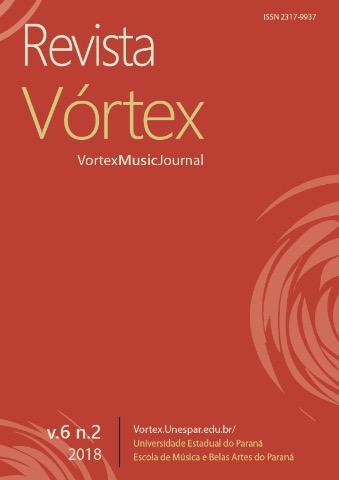Contrasting noises and expanding sounds: the composition process of Caminantes I to IV
DOI:
https://doi.org/10.33871/23179937.2018.6.2.2606Resumo
This article explores some of the compositional techniques of a cycle of four pieces called Caminantes. Firstly, it comments on the importance of timbre and texture, the starting point for my own creation of material and its articulation. In this part, the contributions of different composers of the 20th Century are discussed, in order to contextualise the ideas and techniques used in the composition of the Caminantes cycle. Then there is an analysis of the compositions from the point of view of form, extended techniques, harmony, microtonality and indeterminacy. The analysis is aided by digital audio analysis, i.e. spectrograms as well as by sections of the score.Downloads
Referências
BERRY, Wallace. Structural Functions in Music. New York: Dover Pub. Inc., 1987.
CROSS, Jonathan. The Stravinsky legacy. Cambridge: Cambridge University Press, 2005.
DUNSBY, Jonathan. Considerations of Texture, Music & Letters, Oxford, v. 70, n. 1, 46-57, 1989.
FINEBERG, Joshua. Spectral Music. Contemporary Music Review, Amsterdam, v. 19, n. 2, 1-5, 2000.
KACZYNSKI, Tadeusz. Conversations with Witold Lutosławski, London: J. & W. Chester/Edition Wilhelm Hansen London Ltd., 2012.
KLEIN, Michael. Texture, Register, and Their Formal Roles in the Music of Witold Lutosławski. Indiana Theory Review, Bloomington, v. 20, n. 1, 37-70, 1999.
MATTIS, Olivia. Varèse and Dada. In: LEGGIO, James (Org.) Music and Modern Art. New York: Routledge, 2002.
MACHADO, Antonio. Campos de Castilla, Madrid: Ediciónes Cátedra, 1986.
MAIA, Igor. Caminantes I. Paris: Babel Scores, 2010. Score.
MAIA, Igor. Caminantes II. Paris: Babel Scores, 2011. Score.
MAIA, Igor. Caminantes III. Paris: Babel Scores, 2013. Score.
MAIA, Igor. Caminantes IV. Paris: Babel Scores, 2015. Score
MIRKA, Danuta. To cut the Gordian knot: the timbre system of Krzystof Penderecki. Journal of Music Theory, New Haven, v. 45, n. 2, 435-456, 2001.
MURAIL, Tristan. Scelsi, De-composer. Contemporary Music Review, London, v. 24, n. 2/3, 173-180, 2005.
NONKEN, Marilyn. The Spectral Piano. Cambridge: Cambridge University Press, 2014.
PADOVANI, José Henrique; FERRAZ, Silvio. Proto-história, evolução e situação atual das técnicas estendidas na criação musical e na performance. Revista Musica Hodie, Goiânia, v. 11, n. 2, 11-35, 2011.
RYAN, David. Composer in Interview: Helmut Lachenmann. Tempo, New Series, n. 210, 20-25, 1999.
SCHOENBERG, Arnold. Theory of Harmony. Oakland: University of California Press, 1978.
SINGLETON, Philip. A survey of the consequences for contemporary composition of the French Spectral School of the 1970s and 1980s, Thesis, Department of Music and Media, University of Surrey, Surrey, 2015.
TEXTURE. Grove Music Online. Oxford Music Online, Oxford University Press, accessed July 12, 2017, http://0-www.oxfordmusiconline.com.catalogue.libraries.london.ac.uk/subscriber/article/grove/music/27758.
VARÈSE, Edgard; WEN-CHUNG, Chou. The Liberation of Sound. Perspectives of New Music, v. 5, n. 1, 11-19, 1966.
WHITTALL, Arnold. The Cambridge introduction to serialism. Cambridge: Cambridge University Press, 2008.
Downloads
Publicado
Como Citar
Edição
Seção
Licença
Copyright (c) 2021 Igor Leão Maia

Este trabalho está licenciado sob uma licença Creative Commons Attribution 4.0 International License.
Autores mantêm os direitos autorais e concedem à revista o direito de primeira publicação, com o trabalho simultaneamente licenciado sob a Licença Creative Commons Attribution que permite o compartilhamento do trabalho com reconhecimento da autoria e publicação inicial nesta revista.






